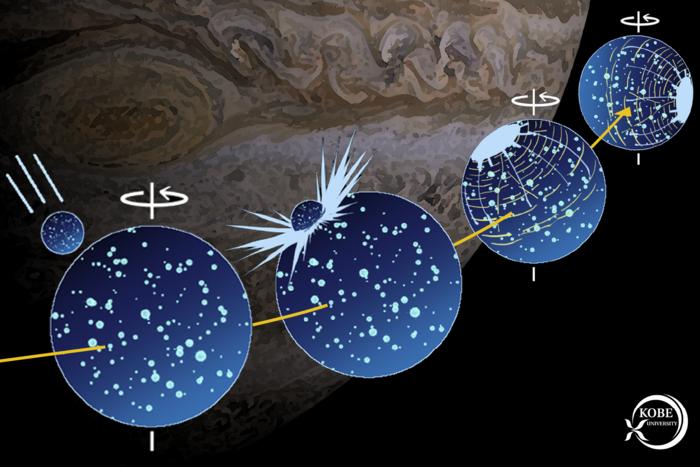Around 4 billion years ago, an asteroid hit the Jupiter moon Ganymede. Now, a Kobe University researcher realized that the Solar System’s biggest moon’s axis has shifted as a result of the impact, which confirmed that the asteroid was around 20 times larger than the one that ended the age of the dinosaurs on Earth, and caused one of the biggest impacts with clear traces in the Solar System.

Credit: HIRATA Naoyuki
Around 4 billion years ago, an asteroid hit the Jupiter moon Ganymede. Now, a Kobe University researcher realized that the Solar System’s biggest moon’s axis has shifted as a result of the impact, which confirmed that the asteroid was around 20 times larger than the one that ended the age of the dinosaurs on Earth, and caused one of the biggest impacts with clear traces in the Solar System.
Ganymede is the largest moon in the Solar System, bigger even than the planet Mercury, and is also interesting for the liquid water oceans beneath its icy surface. Like the Earth’s moon, it is tidally locked, meaning that it always shows the same side to the planet it is orbiting and thus also has a far side. On large parts of its surface, the moon is covered by furrows that form concentric circles around one specific spot, which led researchers in the 1980s to conclude that they are the results of a major impact event. “The Jupiter moons Io, Europa, Ganymede and Callisto all have interesting individual characteristics, but the one that caught my attention was these furrows on Ganymede,” says the Kobe University planetologist HIRATA Naoyuki. He continues, “We know that this feature was created by an asteroid impact about 4 billion years ago, but we were unsure how big this impact was and what effect it had on the moon.”
Data from the remote object is scarce making research very difficult, and so Hirata was the first to realize that the purported location of the impact is almost precisely on the meridian farthest away from Jupiter. Drawing from similarities with an impact event on Pluto that caused the dwarf planet’s rotational axis to shift and that we learned about through the New Horizons space probe, this implied that Ganymede, too, had undergone such a reorientation. Hirata is a specialist in simulating impact events on moons and asteroids, so this realization allowed him to calculate what kind of impact could have caused this reorientation to happen.
In the journal Scientific Reports, the Kobe University researcher now published that the asteroid probably had a diameter of around 300 kilometers, about 20 times as large as the one that hit the Earth 65 million years ago and ended the age of the dinosaurs, and created a transient crater between 1,400 and 1,600 kilometers in diameter. (Transient craters, widely used in lab and computational simulations, are the cavities produced directly after the crater excavation and before material settles in and around the crater.) According to his simulations, only an impact of this size would make it likely that the change in the distribution of mass could cause the moon’s rotational axis to shift into its current position. This result holds true irrespective of where on the surface the impact occurred.
“I want to understand the origin and evolution of Ganymede and other Jupiter moons. The giant impact must have had a significant impact on the early evolution of Ganymede, but the thermal and structural effects of the impact on the interior of Ganymede have not yet been investigated at all. I believe that further research applying the internal evolution of ice moons could be carried out next,” explains Hirata.
Interesting for its subsurface oceans, Ganymede is the final destination of ESA’s JUICE space probe. If everything goes well, the spacecraft will enter orbit around the moon in 2034 and will make observations for six months, sending back a wealth of data that will help answer Hirata’s questions.
This research was funded by the Japan Society for the Promotion of Science (grants 20K14538 and 20H04614) and the Hyogo Science and Technology Association.
Kobe University is a national university with roots dating back to the Kobe Commercial School founded in 1902. It is now one of Japan’s leading comprehensive research universities with nearly 16,000 students and nearly 1,700 faculty in 10 faculties and schools and 15 graduate schools. Combining the social and natural sciences to cultivate leaders with an interdisciplinary perspective, Kobe University creates knowledge and fosters innovation to address society’s challenges.
Journal
Scientific Reports
Method of Research
Computational simulation/modeling
Subject of Research
Not applicable
Article Title
Giant impact on early Ganymede and its subsequent reorientation
Article Publication Date
3-Sep-2024



